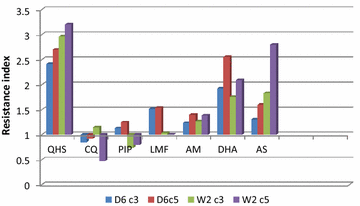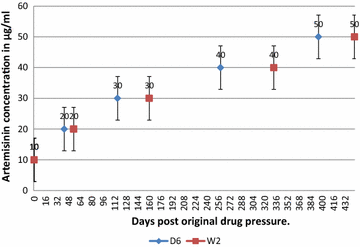In vitro selection of Plasmodium falciparum Pfcrt and Pfmdr1 variants by artemisinin
- PMID: 27449110
- PMCID: PMC4957835
- DOI: 10.1186/s12936-016-1443-y
In vitro selection of Plasmodium falciparum Pfcrt and Pfmdr1 variants by artemisinin
Abstract
Background: Anti-malarial drugs are the major focus in the prevention and treatment of malaria. Artemisinin-based combination therapy (ACT) is the WHO recommended first-line treatment for Plasmodium falciparum malaria across the endemic world. Also ACT is increasingly relied upon in treating Plasmodium vivax malaria where chloroquine is failing. The emergence of artemisinin drug-resistant parasites is a serious threat faced by global malaria control programmes. Therefore, the success of treatment and intervention strategies is highly pegged on understanding the genetic basis of resistance.
Methods: Here, resistance in P. falciparum was generated in vitro for artemisinin to produce levels above clinically relevant concentrations in vivo, and the molecular haplotypes investigated. Genomic DNA was extracted using the QIAamp mini DNA kit. DNA sequences of Pfk13, Pfcrt and Pfmdr1 genes were amplified by PCR and the amplicons were successfully sequenced. Single nucleotide polymorphisms were traced by standard bidirectional sequencing and reading the transcripts against wild-type sequences in Codon code Aligner Version 5.1 and NCBI blast.
Results: Exposure of parasite strains D6 and W2 to artemisinin resulted in a decrease in parasite susceptibility to artemisinin (W2 and D6) and lumefantrine (D6 only). The parasites exhibited elevated IC50s to multiple artemisinins, with >twofold resistance to artemisinin; however, the resistance index obtained with standard methods was noticeably less than expected for parasite lines recovered from 50 µg/ml 48 h drug pressure. The change in parasite susceptibility was associated with Pfmdr-185K mutation, a mutation never reported before. The Pfcrt-CVMNK genotype (Pfcrt codons 72-76) was retained and notably, the study did not detect any polymorphisms reported to reduce P. falciparum susceptibility in vivo in the coding sequences of the Pfk13 gene.
Discussion: This data demonstrate that P. falciparum has the capacity to develop resistance to artemisinin derivatives in vitro and that this phenotype is achieved by mutations in Pfmdr1, the genetic changes that are also underpinning lumefantrine resistance. This finding is of practical importance, because artemisinin drugs in Kenya are used in combination with lumefantrine for the treatment of malaria.
Conclusion: Artemisinin resistance phenotype as has been shown in this work, is a decrease in parasites susceptibility to artemisinin derivatives together with the parasite's ability to recover from drug-induced dormancy after exposure to drug dosage above the in vivo clinical concentrations. The study surmises that Pfmdr1 may play a role in the anti-malarial activity of artemisinin.
Keywords: Artemisinin; Drug resistance; Malaria.
Figures


Similar articles
-
Selection of Plasmodium falciparum pfcrt and pfmdr1 polymorphisms after treatment with artesunate-amodiaquine fixed dose combination or artemether-lumefantrine in Liberia.Malar J. 2016 Sep 5;15(1):452. doi: 10.1186/s12936-016-1503-3. Malar J. 2016. PMID: 27596849 Free PMC article. Clinical Trial.
-
Molecular surveillance of anti-malarial resistance pfcrt, pfmdr1, and pfk13 polymorphisms in African Plasmodium falciparum imported parasites to Wuhan, China.Malar J. 2021 May 1;20(1):209. doi: 10.1186/s12936-021-03737-8. Malar J. 2021. PMID: 33933099 Free PMC article.
-
The role of Pfmdr1 and Pfcrt in changing chloroquine, amodiaquine, mefloquine and lumefantrine susceptibility in western-Kenya P. falciparum samples during 2008-2011.PLoS One. 2013 May 13;8(5):e64299. doi: 10.1371/journal.pone.0064299. Print 2013. PLoS One. 2013. PMID: 23675533 Free PMC article.
-
Molecular Mechanisms of Drug Resistance in Plasmodium falciparum Malaria.Annu Rev Microbiol. 2020 Sep 8;74:431-454. doi: 10.1146/annurev-micro-020518-115546. Annu Rev Microbiol. 2020. PMID: 32905757 Free PMC article. Review.
-
Drug resistance markers within an evolving efficacy of anti-malarial drugs in Cameroon: a systematic review and meta-analysis (1998-2020).Malar J. 2021 Jan 9;20(1):32. doi: 10.1186/s12936-020-03543-8. Malar J. 2021. PMID: 33422080 Free PMC article.
Cited by
-
Artesunate Suppresses Choroidal Melanoma Vasculogenic Mimicry Formation and Angiogenesis via the Wnt/CaMKII Signaling Axis.Front Oncol. 2021 Aug 12;11:714646. doi: 10.3389/fonc.2021.714646. eCollection 2021. Front Oncol. 2021. PMID: 34476217 Free PMC article.
-
Naturally Acquired Kelch13 Mutations in Plasmodium falciparum Strains Modulate In Vitro Ring-Stage Artemisinin-Based Drug Tolerance and Parasite Survival in Response to Hyperoxia.Microbiol Spectr. 2022 Oct 26;10(5):e0128221. doi: 10.1128/spectrum.01282-21. Epub 2022 Sep 12. Microbiol Spectr. 2022. PMID: 36094220 Free PMC article.
-
Artemisinin and Its Derivatives as a Repurposing Anticancer Agent: What Else Do We Need to Do?Molecules. 2016 Oct 7;21(10):1331. doi: 10.3390/molecules21101331. Molecules. 2016. PMID: 27739410 Free PMC article. Review.
-
Are k13 and plasmepsin II genes, involved in Plasmodium falciparum resistance to artemisinin derivatives and piperaquine in Southeast Asia, reliable to monitor resistance surveillance in Africa?Malar J. 2019 Aug 23;18(1):285. doi: 10.1186/s12936-019-2916-6. Malar J. 2019. PMID: 31443646 Free PMC article.
-
Origin and Spread of Evolving Artemisinin-Resistant Plasmodium falciparum Malarial Parasites in Southeast Asia.Am J Trop Med Hyg. 2019 Dec;101(6):1204-1211. doi: 10.4269/ajtmh.19-0379. Am J Trop Med Hyg. 2019. PMID: 31642425 Free PMC article. Review.
References
MeSH terms
Substances
LinkOut - more resources
Full Text Sources
Other Literature Sources
Research Materials

